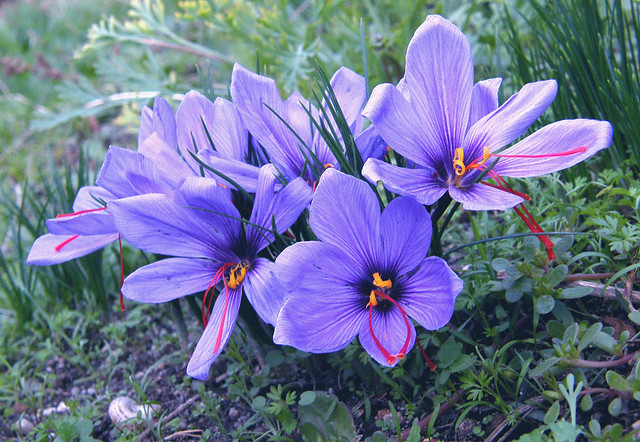La Rosa del Azafrán Posted by Magda on Oct 7, 2010 in Spanish Culture
Los árabes hicieron aportaciones de enorme valor a la Península Ibérica durante su ocupación entre los siglos VIII y XV, gracias a sus amplios conocimientos matemáticos, astrológicos, médicos, literarios, etc. Pero también a su paso por España debemos hoy el cultivo de una delicada flor, y lo que es más importante, del preciado producto que esconde en su centro: el azafrán.
Esta sencilla planta fue introducida alrededor del siglo IX, aunque en aquella época era usada exclusivamente por la alta nobleza andalusí. Poco a poco su cultivo se fue enraizando en la tierra castellana, de tal forma que hoy día existen diversos festejos relacionados con él: la Fiesta de la Rosa del Azafrán de Consuegra (Toledo), los concursos de monda que se celebran en La Solana (Ciudad Real) con motivo de sus fiestas patronales o el Festival de la Rosa del Azafrán de Santa Ana (Albacete).
El azafrán es hoy día una especia muy valorada, por lo que se pone especial cuidado en su recolección, y sigue siendo una labor tradicional y familiar. Cuando el campo se tiñe de violeta, verde y rojo en las últimas semanas de octubre, los azafraneros deben madrugar para recoger la flor antes de que el sol de media mañana haga que se marchite. Se usan tradicionales cestos de mimbre, y una vez recolectada, hay que apresurarse a la “monda”, antes de que los pétalos se marchiten, y hagan más difícil la labor. Esta tarea ha dado lugar hoy a concursos muy concurridos, donde locales y foráneos compiten en este arte de obtener los preciados estigmas de azafrán. Tras esto, se procede al tueste de los mismos sobre brasas, procedimiento único de Castilla, ya que tradicionalmente en otras zonas, se dejaban secar al sol.
El valor que puede alcanzar un kilo de azafrán ronda los 3.500€. Quizá sea por esto que pervive la costumbre de ofrecer a las parejas de recién casados unas briznas de azafrán, como deseos de prosperidad.
Con esto me despido, y os invito a visitar el último fin de semana de Octubre este festival de la Rosa del Azafrán en Consuegra, fiesta de interés cultural hoy día, y disfrutar extrayendo este oro rojo de la flor: además de curioso, ¡es francamente entretenido!

by vega
Arabs made very valuable contributions to the Iberian Peninsula during their occupation between the 8th and 15th century, thanks to their vast knowledge of mathematics, astrology, medicine, literature, etc. But their stay in Spain also rewarded us with the growing of a delicate flower and, what’s more important, the precious product hidden inside it: saffron.
This simple plant was introduced around the 9th century, although in that time it was consumed exclusively by the Andalusi nobles. Little by little, the crop became established in Castilian lands, to the point that today we have several festivities associated with it: the Feast of the Saffron Rose in Consuegra (Toledo), the peeling competitions held in La Solana (Ciudad Real) during their patron saint festival, or the Saffron Rose Festival in Santa Ana (Albacete).
Saffron is a very expensive spice today, so special care has to be taken during its harvest, which is still a traditional family job. When the fields turn purple, green, and red during the last weeks of October, saffron pickers have to get up early to pluck the flowers before the morning sun wilts them. They use traditional woven wicker baskets and, once harvested, they have to peel them really quickly, before the petals wilt, making the task even more difficult. This task has spurred modern well-attended competitions, where locals and visitors compete in the art of extracting the precious saffron stigmas. After that, they are toasted over hot coals, a procedure that’s unique in Castile, since in other regions they’re simply sun-dried.
The price of a kilogram of saffron (2.2 lbs) is around 3,500€. Perhaps as a result of this high value it is still customary to offer newly married couples a few saffron threads as a sign of prosperity.
I’ll leave you with this, and I invite everyone to visit the Saffron Rose Festival in Consuegra (Heritage of Cultural Interest) during the last weekend of October. You will be able to have fun extracting this red gold from the flower: apart from being interesting, it is truly entertaining!

Build vocabulary, practice pronunciation, and more with Transparent Language Online. Available anytime, anywhere, on any device.



